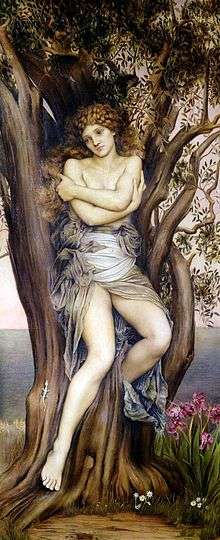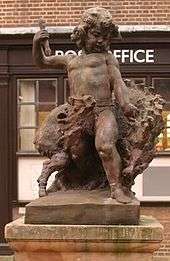Dryad
A dryad (/ˈdraɪ.æd/; Greek: Δρυάδες, sing.: Δρυάς) is a tree nymph or tree spirit in Greek mythology. Drys signifies "oak" in Greek, and dryads are specifically the nymphs of oak trees, but the term has come to be used for tree nymphs in general,[1] or human-tree hybrids in fantasy. They were normally considered to be very shy creatures except around the goddess Artemis, who was known to be a friend to most nymphs.
 The Dryad by Evelyn De Morgan. | |
| Grouping | Legendary creature |
|---|---|
| Country | Greece |
Types
| Greek deities series |
|---|
| Nymphs |
Daphnaie
These were nymphs of the laurel trees.
Epimelides
The Maliades, Meliades or Epimelides were nymphs of apple and other fruit trees and the protectors of sheep. The Greek word melas—from which their name derives—means both apple and sheep. Hesperides, the guardians of the golden apples were regarded as these type of dryad.
Hamadryad
Dryads, like all nymphs, were supernaturally long-lived and tied to their homes, but some were a step beyond most nymphs. These were the hamadryads who were an integral part of their trees, such that if the tree died, the hamadryad associated with it died as well. For these reasons, dryads and the Greek gods punished any mortals who harmed trees without first propitiating the tree-nymphs. (associated with Oak trees)
Names
Some of the individual dryads or hamadryads are:
In popular culture

- Dryads are mentioned in Milton's Paradise Lost, in the works of Coleridge, and in Thackeray's novel The Virginians.[10] Keats addresses the nightingale as "light-winged Dryad of the trees", in his "Ode to a Nightingale".In Ezra Pound's Pisan Cantos, Canto LXXXIII. In the poetry of Donald Davidson they illustrate the themes of tradition and the importance of the past to the present.[11] The poet Sylvia Plath uses them to symbolize nature in her poetry in "On the Difficulty of Conjuring up a Dryad", and "On the Plethora of Dryads".[12]
- The story "Dear Dryad" (1924) by Oliver Onions features a dryad influencing several romantic couples through history.[13]
- The Lev Grossman’s The Magicians Trilogy, the character Julia becomes a dryad after having had her shade removed during her rape at the hands of Reynard the Fox. Her transformation accelerates when she visits Fillory in the company of the novel’s other principals, and is complete when she and Quentin Coldwater visit Fillory’s underworld. [14]
- Dryads appear in The Chronicles of Narnia book series by C.S. Lewis.
- In the 2005 CG animated film Barbie: Fairytopia, there is a character named Dahlia who is a dryad.
- In the 1940 short story The Hardwood Pile by L. Sprague de Camp, the antagonist is a sphendamniad, a dryad-like spirit whose tree has been made into lumber.
- In 2015, the feature film, Dryads - Girls Don't Cry, was released in Norway.[15]
- In Warcraft III: Reign of Chaos, Frozen Throne, and Reforged dryads are playable night elf characters.
- In Hercules (1997 film) there were some dryads whom Philoctetes was secretly gazing at.
- Dryad Lake in Antarctica is named after the nymphs.[16]
See also
- Ghillie Dhu, a similar Scottish spirit
- Kodama, a similar Japanese spirit
- Green spirit
- Elf
- Querquetulanae, Roman nymphs of the oak
- Salabhanjika, a similar Indian spirit
References
Citations
- Graves, ch. 86.2; p. 289
- Bibliotheca 2. 1. 5
- Tzetzes on Lycophron, 480
- Ovid, Metamorphoses 9.330 ff
- Antoninus Liberalis, Metamorphoses 32
- Pausanias, Description of Greece, 8. 4. 2
- Propertius, Elegies 1. 18
- Nonnus, Dionysiaca 2. 92 ff :
- Pausanias, Description of Greece 10. 32. 9
- J. Simpson; E. Weiner, eds. (1989). "Dryad". Oxford English Dictionary (2nd ed.). Oxford: Clarendon Press. ISBN 0-19-861186-2.
- Martha E. Cook (1979). "Dryads and Flappers". The Southern Literary Journal. University of North Carolina Press. 12 (1): 18–26. JSTOR 20077624.
- Britzolakis, Christina (2000). Sylvia Plath and the theatre of mourning. Oxford English Monographs. Oxford University Press. pp. 85–86. ISBN 0-19-818373-9.
- Norman Donaldson, "Oliver Onions", in E.F. Bleiler, ed. Supernatural Fiction Writers. New York: Scribner's, 1985. pp.505-512. ISBN 0684178087
- Lev Grossman, The Magician King. New York: Viking, 2011. pp.343-357. ISBN 978067002231-1
- https://randalljahnson.com/dryads-girls-dont-cry/
- Dryad Lake. SCAR Composite Gazetteer of Antarctica
Bibliography
- Graves, Robert (1955). Greek Myths. London: Penguin. ISBN 0-14-001026-2.
- Burkert, Walter, 1985. Greek Religion (Cambridge: Harvard University Press).
External links
| Wikimedia Commons has media related to Dryads. |
- Greek Mythology Link: Nymphs.
- Hans Christian Andersen, "The Dryad", 1868 (e-text)
- Andersen, H. C.; Craigie (transl.) "The Dryad" Fairy tales and other stories London; Toronto: Oxford University Press. 1914
- Tim Hoke, "The Dryad", 2002 (e-text; strong language)